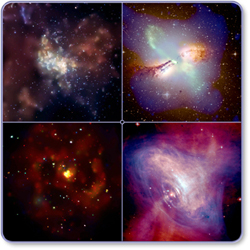September 15, 2003
MSFC Press Release
RELEASE: 03-158
Launched in 1999, NASA's Chandra X-ray Observatory promised to be one of the world's most powerful tools to better understand the structure and evolution of the universe - and it has lived up to expectations.
"In four short years, Chandra has achieved numerous scientific firsts, revealing new details on all categories of astronomical objects including distant galaxies, planets, black holes and stars," said Chandra project scientist Dr. Martin C. Weisskopf of NASA's Marshall Space Flight Center in Huntsville, Ala.
"In the last year alone, Chandra has generated the most sensitive or 'deepest' X-ray exposure ever made, shed new light on the planet Mars, and made several new discoveries involving supermassive black holes," added Weisskopf, who has dedicated nearly 30 years to the Chandra program.
The deepest X-ray exposure, Chandra Deep Field North, captured for 23 days an area of the sky one-fifth the size of the full moon. Even though the faintest sources detected produced only one X-ray photon every four days, Chandra found more than 600 X-ray sources -- most of them supermassive black holes in galaxy centers. If the number of black holes seen in that area of the sky were typical, 300 million supermassive black holes would be detectable over the whole sky.
In our own solar system, another Chandra image offered scientists their first look at X-rays from Mars . Not only did Chandra detect X-rays in the sparse upper atmosphere 750 miles above the planet, it also offered evidence for a faint halo of X-rays extending out 4,350 miles above the Martian surface.
"In its fourth year of operation, Chandra continues to prove itself an engineering marvel," said Chandra Program Manager Keith Hefner at NASA's Marshall Center. "At its highest point, it travels one-third of the way to the Moon, yet it consistently delivers breathtaking results gleaned from millions, sometimes billions, of light years away."
Some of Chandra's most intriguing discoveries involved black holes. Building on previous achievements, including catching a supermassive black hole devouring material in our own Milky Way galaxy, Chandra accomplished even more during its fourth year. The observatory revealed new details about X-ray jets produced by black holes and discovered two black holes flourishing in a single galaxy 400 million light years from Earth.
By tracking, for the first time, the life cycle of large-scale X-ray jets produced by a black hole, Chandra revealed that as the jets evolved, the material in them traveled near the speed of light for several years before slowing and fading. These jets - from a stellar-sized black hole about 10 or so times the mass of the Sun - were the first ones caught in the act of slowing down. This enabled astronomers, in just four years, to observe a process that could take a million years to unfold.
By revealing two active black holes in the nucleus of the extraordinarily bright galaxy NGC 6240, another Chandra image proved for the first time that two supermassive black holes can co-exist in the same galaxy. Currently orbiting each other, in several hundred million years these black holes will merge to create an even larger black hole, resulting in a catastrophic event that will unleash intense radiation and gravitational waves.
Also in Chandra's fourth year, the observatory offered new insights into pulsars - small and extremely dense stars. Generated by a series of Chandra observations, an X-ray movie of the Vela pulsar. revealed a spectacularly erratic jet that varied in a way never before seen. Whipping about like an untended firehose at about half the speed of light, the jet of high-energy particles offered new insight into the nature of jets from pulsars and black holes.
Previous Chandra highlights include revealing the most distant X-ray cluster of galaxies, identifying a pulsating hot spot of X-rays in Jupiter's upper atmosphere, uncovering a ''cool'' black hole at the heart of the Andromeda Galaxy, and finding an X-ray ring around the Crab Nebula.
"For the first four years, interest in the science community has been incredibly high with more than 3,000 different astronomers as investigators on one or more proposals to observe with Chandra,'' said Harvey Tananbaum, director of the Chandra X-ray Center in Cambridge Mass. ''And, it's produced results with several hundred scientific papers about Chandra discoveries in each of the past several years."
About one-billion times more powerful than the first X-ray detector launched from a rocket more than four decades ago, Chandra's resolving power is equal to the ability to read the letters of a stop sign at a distance of 12 miles.
NASA's Marshall Space Flight Center, Huntsville, Ala., manages the Chandra program for the Office of Space Science, NASA Headquarters, Washington. Northrop Grumman of Redondo Beach, Calif., formerly TRW, Inc., was the prime development contractor for the observatory. The Smithsonian Astrophysical Observatory controls science and flight operations from the Chandra X-ray Center in Cambridge, Mass.
Images associated with this release are available at:
MEDIA CONTACTS
Steve Roy
Marshall Space Flight Center, Huntsville, AL
Phone: 256-544-6535



